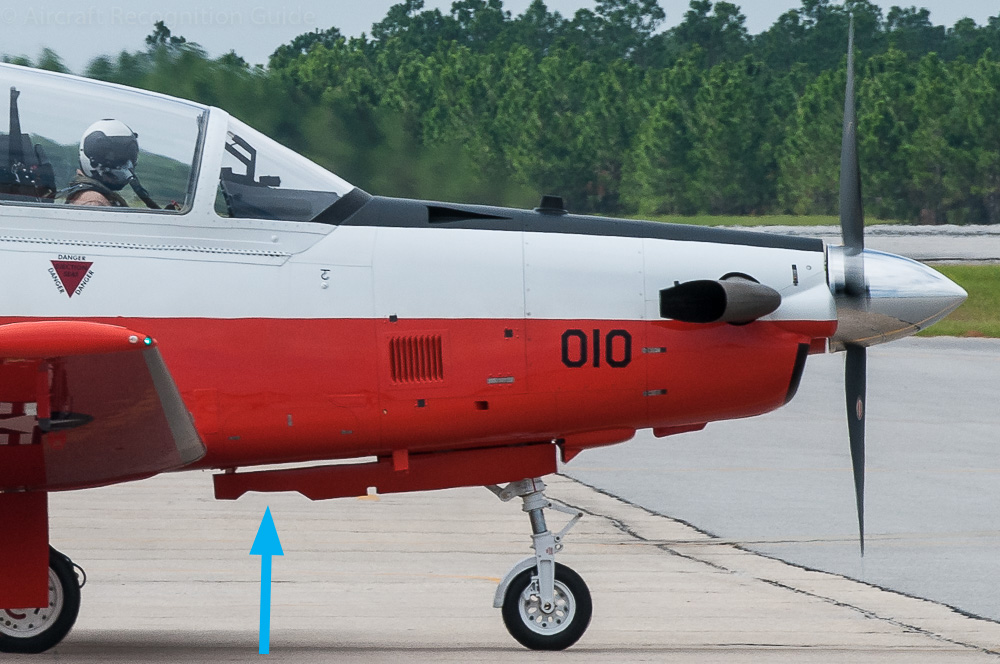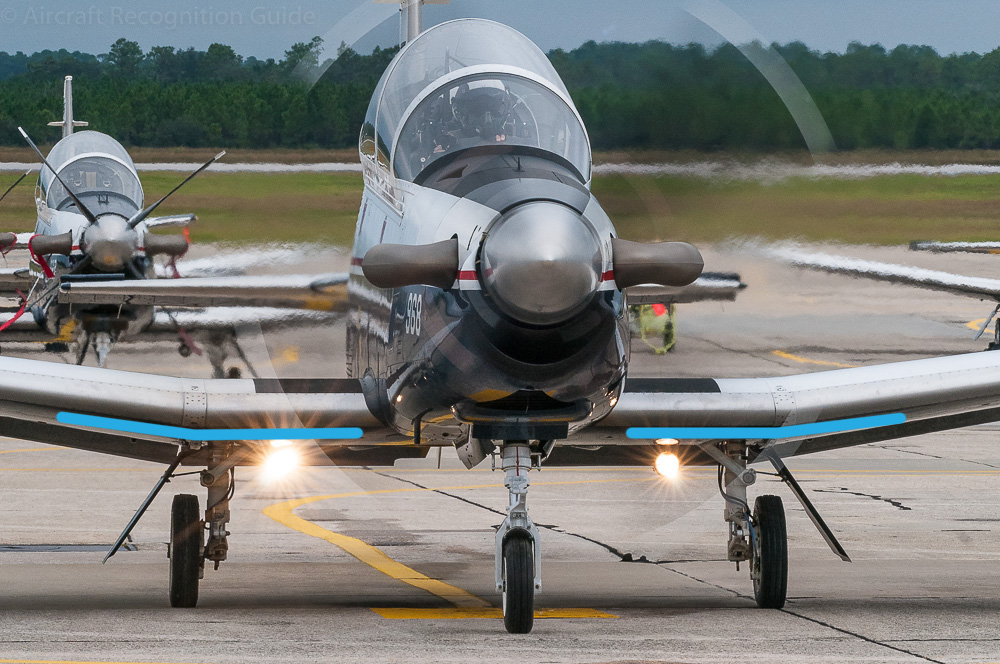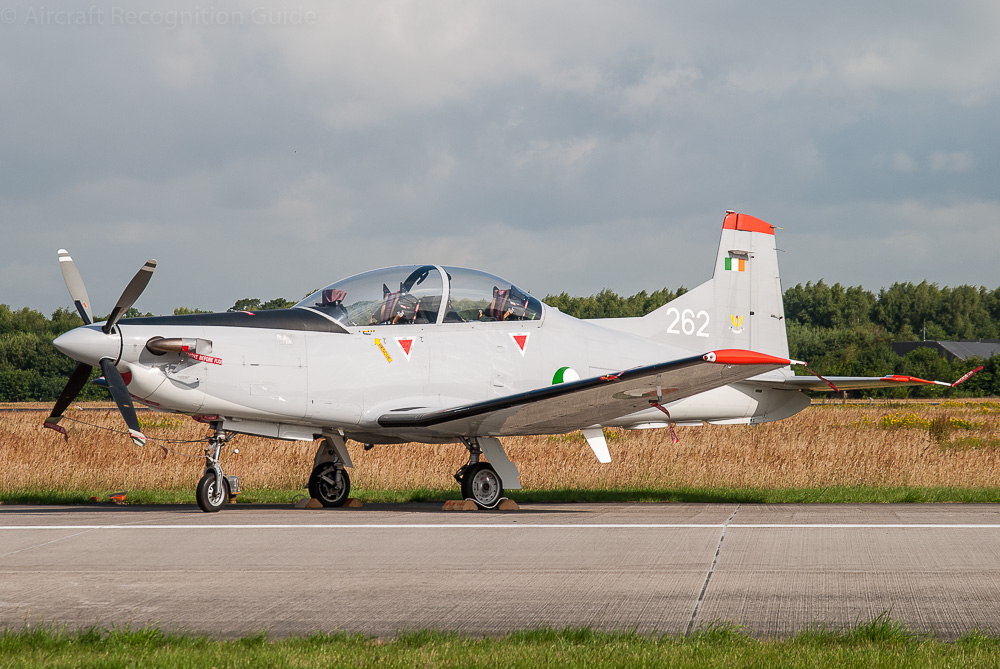
Beechcraft (Raytheon) T-6 Texan II & Wolverine
The team of Pilatus and Raytheon Aircraft was declared the winner of the JPATS competition, the Joint Primary Aircraft Training System in the 1990s. In this programme the US forces sought a replacement for the Cessna T-37 (USAF) and Beechcraft T-34 (US Navy).
Pilatus and Raytheon created a modified Pilatus PC-9, receiving Raytheon model number 3000. Under the US designation system it became known as T-6, and was therefore named Texan II, as the original North American T-6 had the name Texan.
As most high performance turboprop training aircraft the Texan II has low, straight wings, a turboprop engine in the nose and a tandem cockpit, in this case with a three piece canopy, so two bow frames. The aircraft has a conventional tail plane. Like on the PC-9 the first part of the wings, near the roots, has no dihedral, while the outer wings have a significant dihedral. The Texan IIs have a ventral fin below the tail. The dorsal fin is rather small, like on the original PC-9. The nose gear doors have a small opening or recess, in which the nose gear fits when it is retracted.
Different versions
The different versions of the Texan II and Wolverine can be recognised by:
- the presence and number of weapon pylons under the wings
- the presence of a Head-Up Display (HUD)
- the presence of a turret sensor under the fuselage
- the presence of a system cooler under the nose
T-6A Texan II
The A model of the T-6 is the basic training version of the US Air Force and US Navy. It has no head-up display (HUD), which should be visible from the outside. Inside the cockpit you will see many small displays. This original version has no provision for pylons under the wings.
The Canadian air force uses nearly the same version, for the NATO Flying Training in Canada (NFTC) programme. They designate it CT-156.
T-6A NTA Texan II
So far only the Hellenic Air Force has a potentially armed version of the T-6A, called the T-6A NTA. It has a pylon under each wing. The NTA version retains a non HUD cockpit though, and that is the recognition point compared to the AT-6B and later variants.
No head-up display (HUD), but pylons under the wings, so this is a T-6A NTA. (photo: Voytek S/WikiMedia)
T-6B Texan II
The T-6B is similar to the T-6A except for the cockpit. The T-6B has less, but larger displays, and more importantly head-up displays (HUD). The latter should be visible from the outside, especially when viewed from close by.
T-6C & T-6D Texan II
The T-6C is the potentially armed version of the T-6B, with one pylon under each wing. Unlike the T-6A NTA is has the HUDs of the T-6B.
T-6D is the designation of a T-6C with specific roles of the US Army, other than training. We have not identified any differences compared to the T-6C though.
The Royal Air Force calls this version the Texan T1.
The T-6C has a pylon under each wing, which allows it to carry drop tanks or a variety of weapons.
AT-6B, AT-6E & AT-6TH Wolverine
Beechcraft chose a different name for the dedicated light attack version of the T-6, namely Wolverine. There are several versions, AT-6B, AT-6E and AT-6TH. The B variant seems to be the development version, with the E model being the production versions. TH appears to be destined for the export version for Thailand. As the system, sensor and weapon configuration can be custom made, it is difficult to see the difference between the AT-6B and AT-6E. In any case both have three pylons under each wing, and often a round turret sensor under the fuselage (in between the wings) and a system cooler under the nose.
The three pylons under the wings of the AT-6 Wolverine are a clear recognition point compared to the T-6C.
On this frontal shot you can better see two other aspects of the AT-6, the sensor turret underneath the fuselage and the cooler underneath the nose. (photo: Airwolfhoud/WikiMedia)
Confusion possible with
Pilatus PC-9
Being derived from the Pilatus PC-9 it is logical that it share a lot of similarities with the Texan II (although in practice only the tires seem to be exchangeable!). The differences are in the bigger dorsal fin (on most versions), no ventral fin and two piece canopy. The same differences apply to the PC-7 MkII.
Pilatus PC-21
The successor of the PC-9 has a two piece canopy, wings with constant (small) dihedral, a trailing link main landing gear and a shark fin like top of vertical stabiliser.
Pilatus PC-7
The PC-7 has similar wings as the PC-9 and T-6, but a clearly different canopy. This has one frame, close to the front.
Calidus B-250

Another look-a-like is this trainer/light fighter. The dorsal fin of the B-250 is slightly larger and the wings have a constant dihedral, enough to avoid a mix-up with the Texan II. The nose gear is quite close to the prop, but not as much as on the Tucano. (photo: Mztourist/WikiMedia)
KAI KT-1 Woong-Bee

This Korean aircraft also resembles the T-6. Like the PC-9 it has a two piece canopy though and no ventral fin. Also the wings have dihedral along the full span. Finally, the nose gear doors are shorter. (photo: Aldo Bidini/WikiMedia)
Embraer (Super) Tucano
Especially the Super Tucano has a similar canopy with two bow frames as the Texan II, which may confuse you. However, all Tucanos have a nose gear that is close to the prop, much closer than the other aircraft mentioned here.
TAI Hürkuş
The last high performance turboprop training aircraft here has a two piece canopy, a big dorsal fin and small winglets (on most versions) to make identification from the T-6 easy.

















